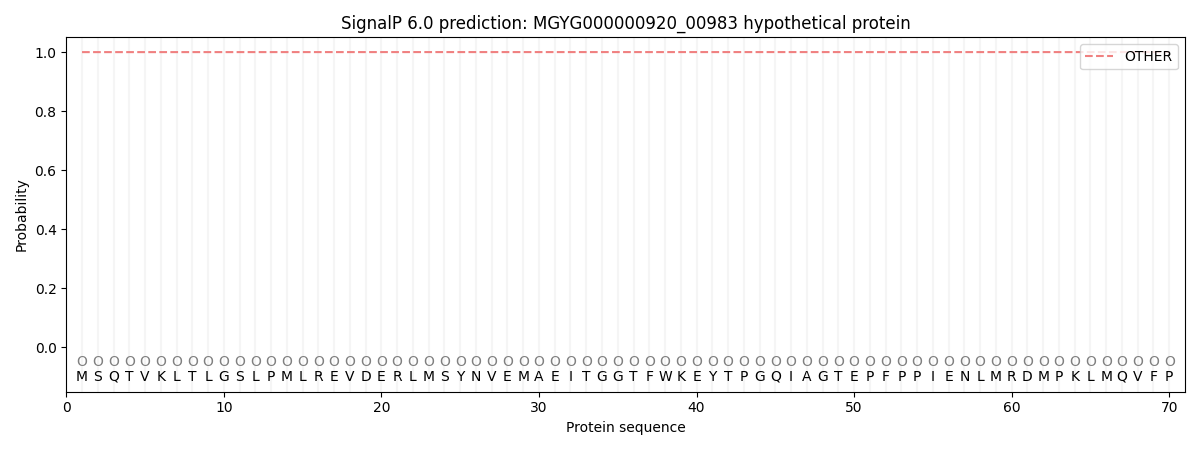You are browsing environment: HUMAN GUT
CAZyme Information: MGYG000000920_00983
You are here: Home > Sequence: MGYG000000920_00983
Basic Information |
Genomic context |
Full Sequence |
Enzyme annotations |
CAZy signature domains |
CDD domains |
CAZyme hits |
PDB hits |
Swiss-Prot hits |
SignalP and Lipop annotations |
TMHMM annotations
Basic Information help
| Species | Gemmiger sp900548355 | |||||||||||
|---|---|---|---|---|---|---|---|---|---|---|---|---|
| Lineage | Bacteria; Firmicutes_A; Clostridia; Oscillospirales; Ruminococcaceae; Gemmiger; Gemmiger sp900548355 | |||||||||||
| CAZyme ID | MGYG000000920_00983 | |||||||||||
| CAZy Family | GH79 | |||||||||||
| CAZyme Description | hypothetical protein | |||||||||||
| CAZyme Property |
|
|||||||||||
| Genome Property |
|
|||||||||||
| Gene Location | Start: 27784; End: 29292 Strand: - | |||||||||||
CAZyme Signature Domains help
| Family | Start | End | Evalue | family coverage |
|---|---|---|---|---|
| GH79 | 70 | 502 | 2.2e-72 | 0.945054945054945 |
CDD Domains download full data without filtering help
| Cdd ID | Domain | E-Value | qStart | qEnd | sStart | sEnd | Domain Description |
|---|---|---|---|---|---|---|---|
| pfam03662 | Glyco_hydro_79n | 3.84e-04 | 73 | 344 | 48 | 315 | Glycosyl hydrolase family 79, N-terminal domain. Family of endo-beta-N-glucuronidase, or heparanase. Heparan sulfate proteoglycans (HSPGs) play a key role in the self- assembly, insolubility and barrier properties of basement membranes and extracellular matrices. Hence, cleavage of heparan sulfate (HS) affects the integrity and functional state of tissues and thereby fundamental normal and pathological phenomena involving cell migration and response to changes in the extracellular micro-environment. Heparanase degrades HS at specific intra-chain sites. The enzyme is synthesized as a latent approximately 65 kDa protein that is processed at the N-terminus into a highly active approximately 50 kDa form. Experimental evidence suggests that heparanase may facilitate both tumor cell invasion and neovascularization, both critical steps in cancer progression. The enzyme is also involved in cell migration associated with inflammation and autoimmunity. |
CAZyme Hits help
| Hit ID | E-Value | Query Start | Query End | Hit Start | Hit End |
|---|---|---|---|---|---|
| AEN98036.1 | 1.67e-244 | 1 | 501 | 1 | 508 |
| SNU86930.1 | 5.90e-223 | 1 | 501 | 1 | 506 |
| AXI08463.1 | 1.35e-218 | 1 | 501 | 1 | 503 |
| QGS68324.1 | 1.35e-218 | 1 | 501 | 1 | 503 |
| QTH47273.1 | 4.59e-211 | 1 | 502 | 1 | 510 |
Swiss-Prot Hits download full data without filtering help
| Hit ID | E-Value | Query Start | Query End | Hit Start | Hit End | Description |
|---|---|---|---|---|---|---|
| X4Y2L4 | 7.35e-19 | 72 | 502 | 40 | 479 | Hyaluronoglucuronidase OS=Hirudo nipponia OX=42736 PE=1 SV=1 |
| Q9LRC8 | 8.28e-16 | 262 | 502 | 270 | 510 | Baicalin-beta-D-glucuronidase OS=Scutellaria baicalensis OX=65409 GN=SGUS PE=1 SV=1 |
| Q8L608 | 9.70e-12 | 72 | 458 | 72 | 446 | Heparanase-like protein 2 OS=Arabidopsis thaliana OX=3702 GN=At5g61250 PE=2 SV=1 |
| Q90YK5 | 2.28e-07 | 300 | 502 | 296 | 514 | Heparanase OS=Gallus gallus OX=9031 GN=HPSE PE=1 SV=1 |
| Q6YGZ1 | 9.35e-07 | 74 | 495 | 67 | 518 | Heparanase OS=Mus musculus OX=10090 GN=Hpse PE=1 SV=3 |
SignalP and Lipop Annotations help
This protein is predicted as OTHER

| Other | SP_Sec_SPI | LIPO_Sec_SPII | TAT_Tat_SPI | TATLIP_Sec_SPII | PILIN_Sec_SPIII |
|---|---|---|---|---|---|
| 1.000032 | 0.000000 | 0.000000 | 0.000000 | 0.000000 | 0.000000 |
